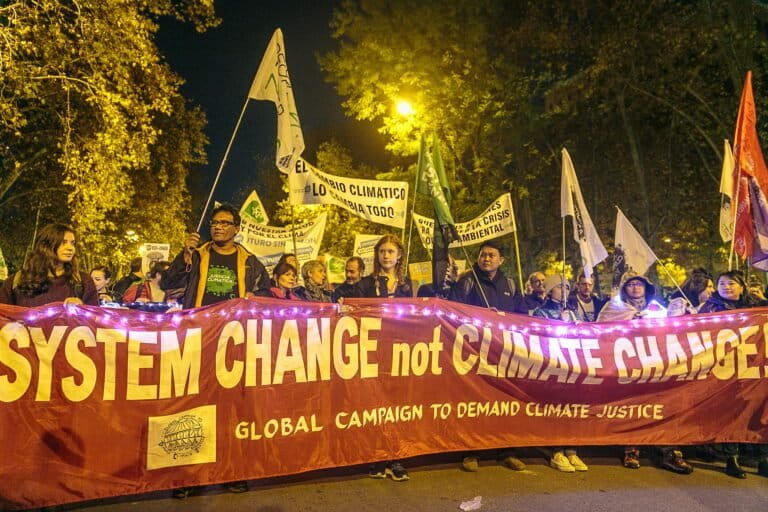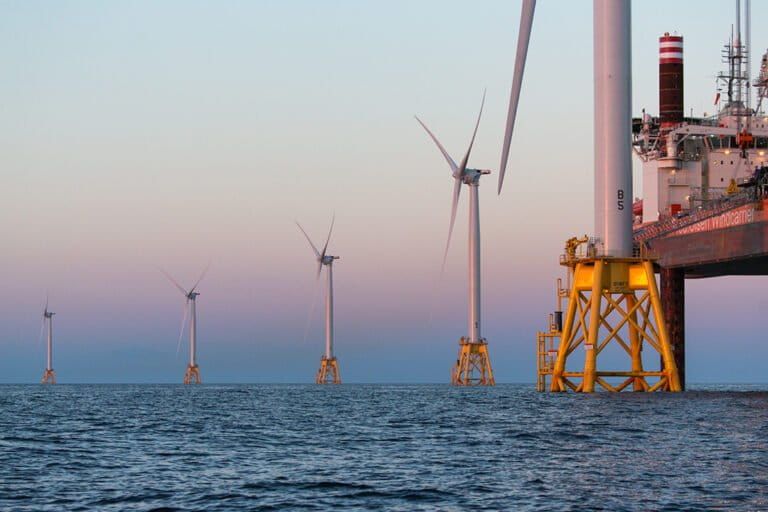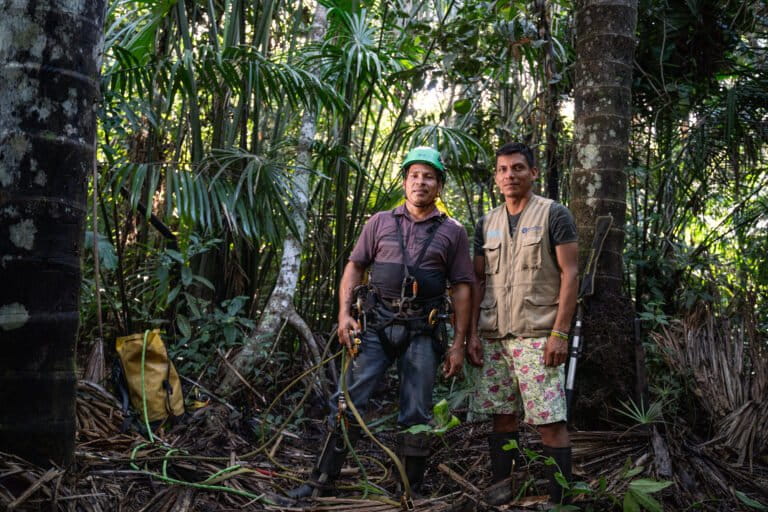- The Indonesian government published a report showing how the country could reap tremendous economic benefits by transitioning to a low-carbon economy.
- According to the report, a low-carbon development path could deliver an average of 6 percent GDP growth per year until 2045, with continued gains in employment, income growth and poverty reduction.
- This strategy would also cut the country’s greenhouse gas emissions nearly 43 percent by 2030, exceeding Indonesia’s international climate target.
- The low-carbon model would require Indonesia to cut its reliance on coal, whereas the government’s current plan is to build more coal-fired power plants.
JAKARTA — With every tree felled and every piece of coal burned for energy, Indonesia is inching closer to its ecological tipping point. And once it passes that point, the country’s economy will greatly suffer, leading to an increase in poverty, a higher mortality rate and lower human development.
That’s the conclusion of a new government-sanctioned report, titled “Low Carbon Development: A Paradigm Shift Towards a Green Economy in Indonesia,” which paints a grim picture of Indonesia’s future should it continue with its current development model.
But the report also asserts that Indonesia can have a much different future — one where its citizens are as wealthy as those of the Netherlands or Germany today — if it transitions to a low-carbon economic model.
Over the decades, Indonesia has exploited its abundant natural resources to feed a population that’s now ballooned to 260 million and fuel an economy that’s among the world’s 15 biggest.
This development model has taken a toll on the environment and public health. Large cities like Jakarta are choked with air pollution. Rivers like the Citarum in West Java are choked with filth. Iconic species like the Sumatran tiger and Javan rhino are teetering on the edge of extinction. The nation’s vast peat swamp zones emit vast quantities of toxic haze due to large-scale drainage and slash-and-burn practices to make way for plantations. They also emit massive amounts of carbon, helping catapult Indonesia to become the fourth-largest greenhouse gas emitter in the world.
The report, sanctioned by the Ministry of Development Planning and a part of the ministry’s initiative to usher in a low-carbon development model, predicts that if Indonesia continues exhausting its natural resources and polluting the environment at the current rate, economic growth will start to gradually decrease beginning in 2019.
This would result from a decrease in the quality of environment, pollution, and scarcity of resources, which would also have a profound impact on mortality rate, leading to 40,000 more annual deaths per year.
The unemployment rate would rise from about 4.1 percent in 2017 to 6.9 percent by 2045, partly due to the health impacts of pollution and environmental degradation, which affects the employability of people of working age.
In addition, there would be a greater pressure on energy needs, leading to increases in price and decreases in productivity.
The cumulative losses of income would be $130 billion over the period 2019-2024, slowing down Indonesia’s annual economic growth to 4.7 percent by 2045, leading to over 1 million more people living in poverty — “a very troubling scenario,” the report says.
“Indonesia is in a position where it can avert further environmental damage by not following the experience of countries such as China, which have polluted and degraded their path out of poverty and into higher income categories,” the report says.
Mari Elka Pangestu, a commissioner of the ministry’s low-carbon development initiative, said the report should serve as a wakeup call for Indonesia to immediately transition away from its current development model and onto a more sustainable path.
“Don’t wait until we become like Beijing or New Delhi,” she said at the launch of the report in Jakarta. “It’s not until they can’t breathe [fresh air] that they start pressuring their governments to change. Let’s be ahead of the curve. Before we can no longer breathe, before we lose our islands, let’s start now.”

A different path
The report lays out its argument for how, should Indonesia adopt a low-carbon development model, it will reap benefits that are both immediate and long lasting.
Through 2024, Indonesia will enjoy an economic growth rate of 5.6 percent, which would further grow into 6 percent through 2045.
As a result, over $5.4 trillion will be added to its GDP in 2045. Its income per capita, which is currently lower than the world’s average, will balloon to nearly $17,000 by 2045, placing the country squarely in the group of developed economies.
Some of those predicted gains by 2045 stem from: 15.3 million additional, good-quality jobs, which are greener and better paid; extreme poverty halving to 4.2 percent of the population relative to 2018; about 40,000 lives saved every year from reduced air and water pollution; and the preservation of nearly 160,000 square kilometers (61,776 square miles) of forests that would otherwise have been cut down — an area larger than England.
Additionally, air quality and living conditions will have vastly improved, and the opportunity gap between women and men, and between provinces, will have diminished.
And due to less reliance on high-carbon economic activities, Indonesia will be able to slash its greenhouse gas emissions nearly 43 percent by 2030, surpassing its climate target of reducing between 29 percent and 41 percent of emissions depending on foreign assistance.
The report acknowledges that transitioning to a low-carbon economic model will require a dramatic overhaul of how the country manages its natural resources and meets the energy demands of its citizens.
For one, Indonesia would have to move away from coal and increase the share of renewable energy in the power sector to at least 30 percent by 2045. The report says renewable energy is now cheaper than coal in Indonesia when the externalized costs of air pollution are taken into account.
“Indonesia’s continued reliance on coal is built upon a now-outdated perception that the cost of coal is lower than alternative sources of energy, along with a set of political economy considerations,” the report says.
Furthermore, Indonesia has to reduce energy intensity (units of energy per unit of GDP) by 3.5 percent in 2030, and by 4.5 percent afterward.
To feed its growing population, the report continues, Indonesia should focus on increasing its land productivity by 4 percent each year, enabling its farmers to grow more food for more people using fewer resources, instead of on clearing more forests.
In fact, Indonesia needs to fully enforce existing moratoriums on forest clearance, oil palm expansion, coal expansion and peatland development as well as reforesting more than 10,000 square kilometers (3,861 square miles) of land per year by 2024.
If Indonesia manages to do so, by 2045 it will still contain 411,000 square kilometers (158,687 square miles) of primary forest, and nearly 150,000 square kilometers (57,915 square miles) of peatlands.
“Of special interest are primary forests, such as those in Papua and Kalimantan, and key [peatlands] and mangrove systems that support biodiversity, enhance resilience and contribute to carbon emissions reduction targets,” the report says.
Lastly, Indonesia will have to meet existing national and international targets for water, fisheries and biodiversity conservation.

A reliance on coal
Observers say all these talks about transitioning to a low-carbon economy would mean nothing if the country couldn’t end its coal addiction.
Currently, Indonesia still relies on fossil fuels to power its economy, with coal generating 58.6 percent of electricity, followed by gas with 22.5 percent, oil with 6.2 percent. Renewable energy only accounts for 12.7 percent of electricity.
While the government has set a target to increase renewable energy portion to 23 percent by 2025, it has also planned to continue relying on coal for foreseeable future in order to meet its ambitious target of adding 35,000 megawatts of power generation to the national grid over the coming years.
Recently, Energy and Mineral Resources Minister Ignasius Jonan said coal-fired power plants would still dominate the country’s electricity supply at 54.6 percent in 2025, even higher than the government’s previous plan.
The government even revived some coal power plant projects, namely the PLTU Java 5 and Java 9-10 projects. The projects had previously been eliminated from last year’s electricity procurement plan (RUPTL), but they reappeared in this year’s plan, despite warning from environmentalists that they will cause massive pollution.
“[In] terms of planning for additional generation capacity, the RUPTL remains anchored in old technology and is overly reliant on fossil fuels,” the Institute for Energy, Economics and Financial Analysis (IEEFA), a think tank, said in an analysis.
Environmental advocates, therefore, are skeptical that the transition to a low-carbon economy will happen, seeing how a coal power plant will remain in operation for at least four decades once it starts operating, locking Indonesia in a high-carbon economic development.
“If the government truly wants to transition, then it should’ve stopped the 35,000-megawatt project, especially those that still rely on fossil fuels and coal,” Even Sembiring, the policy assessment manager at the Indonesian Forum for the Environment (Walhi), told reporters.
He added that the next five-year development plan should include a mechanism to review projects that could hinder the transition process.
“The development plan should regulate how many permits should be evaluated in a certain year and how many coal should be reduced,” Even said. “But with the 35,000 megawatts project, the government instead builds energy infrastructure that relies on coal. That just doesn’t make any sense.”
Medrilzam, the head of the environmental department at the planning ministry, known by its Indonesian acronym Bappenas, admitted that the government’s plan to build more coal-fired power plants would make it more challenging for Indonesia to transition.
“When it comes to coal, it’s impossible to phase it out in a matter of five years because the contract [for coal plants] is a long term one,” he said. “There’s no way we can fully ditch coal, not even by 2045.”
Therefore, Medrilzam said the least the government could do was to manage the demand for electricity by promoting things like electric vehicles and biofuels.
“If the coal projects are already included in the electricity procurement plan, then we’re stuck,” he said. “That’s why, the only option for us is to manage our electricity demand.”
Medrilzam added that some people and businesses— especially those that rely on high-carbon sectors and resource extraction— would be negatively impacted by the shift to a low-carbon economy.
“There must be a trade off,” he said. “That’s why the shift will be gradual. Those affected will be given time to adjust their business model. We have to give ample time for them to shift their investments.”

False dichotomy?
Bambang Brodjonegoro, Indonesia’s minister for national development planning, said the report should put an end to the longstanding debate between environmentalists and business interests.
For decades, environmental advocates have been arguing that exploiting natural resources poses severe risks to the climate and the environment.
Businesses counter that by saying that jobs will be lost and the economy will suffer if the exploitation of natural resources are subject to exhaustive environmental regulations and review.
The debate, therefore, has been reduced to a forced choice that pits the interests of the environment directly against the interests of the economy.
“The low-carbon development path can bridge these two camps,” Bambang said. “So we reverse [our mindset] from growing our economy and emitting greenhouse gas emissions to reducing our emissions while maintaining our economic growth.”
Lord Nicholas Stern, co-chair of the Global Commission on the Economy and Climate, said the report should serve as a map for a more sustainable future for Indonesia.
“The LCDI report provides proof that you can grow economy and generate more quality jobs while reducing emissions,” he said. “Low-carbon growth drives growth itself, the transition is a driver and it leads to a better health, job and investment value. In the short run and in the long run, this transition is the only growth pathway for Indonesia in the future.”
In order to make sure that the transition happens, the planning ministry will incorporate the report into the next mid-term development plan, which will become the country’s first green development plan.
The plan, which will succeed the current five-year plan that expires in 2019, will center on quantifying the country’s ecological resources and planning its economic development accordingly, to prevent the depletion of those resources.
“The low-carbon development initiative will become an integral part of the next five-year development plan, which we’re currently being finalizing,” Bambang said. “The point is that we have to do it in the next five years.”
Given Indonesia’s outsized impact on the global climate, transitioning now to a low carbon economy will be good not only for Indonesia, but for the whole world, according to think-tank World Resources Institute (WRI).
“Perhaps just as important, other governments can learn from the country’s example,” WRI said in a blog post. “Indonesia’s new development plan is ambitious, yes, but it is also necessary, achievable and economically prudent. If Indonesia – an emerging economy with an imperative to improve its people’s standard of living – can pull off low carbon development, then other countries can, too.”
Banner image: Rainforest interior in Riau province, on the east coast of Indonesia’s Sumatra Island. Image by Rhett A. Butler/Mongabay.














